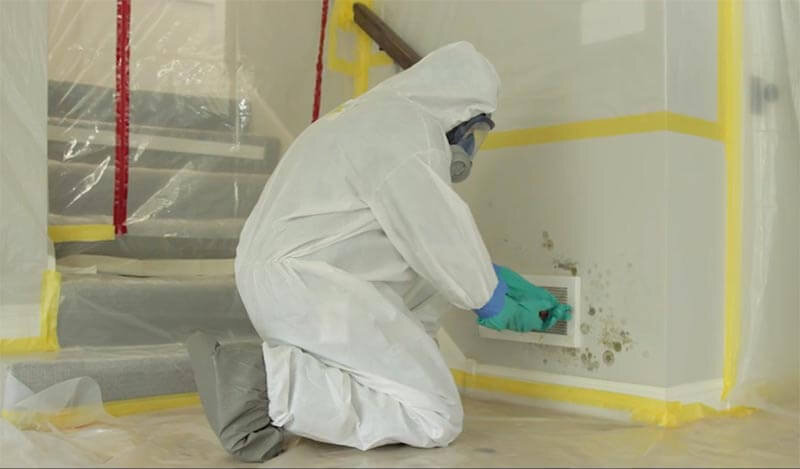Professional Tips for Message Mold Remediation Success
In the realm of mold removal, effectively eliminating mold is only half the battle; the real challenge exists in avoiding its reappearance. By adhering to experienced tips and ideal practices, individuals can safeguard their rooms versus mold renewal and maintain a healthy and balanced indoor environment.
Display Moisture Levels Frequently
After completing mold and mildew removal procedures, maintaining ideal humidity levels is vital to protect against mold re-growth and guarantee a healthy interior atmosphere. High moisture levels over 60% develop a helpful environment for mold and mildew to flourish, making normal keeping track of an aggressive action to prevent any future mold problems.
In addition, establishing a regular schedule for moisture checks, specifically in high-risk locations such as washrooms, cellars, and kitchen areas, is an aggressive approach to mold and mildew avoidance. By constantly keeping track of humidity levels, home proprietors can efficiently mitigate the danger of mold and mildew reoccurrence and maintain a healthy indoor atmosphere post-remediation.
Conduct Thorough Inspections Post-Remediation
Complying with the conclusion of mold removal procedures, it is critical to carry out thorough examinations to validate the effectiveness of the remediation process. These post-remediation evaluations are vital in ensuring that the mold and mildew issue has actually been effectively addressed which there is no reappearance or remaining mold development. Assessments ought to be carried out by certified professionals who have know-how in determining mold and mildew and examining indoor air top quality.
During these evaluations, numerous methods such as aesthetic assessments, air sampling, and surface sampling might be employed to thoroughly assess the remediated areas. Aesthetic evaluations involve a thorough examination of the facilities to look for any noticeable signs of mold growth or water damages. Air tasting assists in determining the air-borne mold and mildew spore degrees, while surface sampling can spot mold and mildew bits on surfaces.
Implement Appropriate Ventilation Techniques
After making sure the performance of the mold remediation process with extensive inspections, the following crucial action is to concentrate on executing appropriate ventilation strategies. Ample ventilation is necessary in avoiding mold and mildew reoccurrence by regulating dampness levels and advertising air flow.
Correct air flow not only help in preventing mold and mildew growth yet also adds to the overall health and convenience of residents. By making sure ample air flow throughout the residential property, you can lower the threat of mold regrowth and create a healthier living atmosphere. Routine upkeep of air flow systems, including cleansing and filter replacements, is crucial to sustaining reliable ventilation. Consulting with heating and cooling specialists can supply additional insights into optimizing ventilation strategies for your certain residential property requirements.

Usage Mold-Resistant Products for Repair Works
To improve the long-term efficiency of mold removal initiatives, including mold-resistant materials for repair work is critical in minimizing the risk of future mold and mildew development. Mold-resistant products are made to withstand moisture and hinder mold growth, making them an essential selection for locations prone to moisture and humidity. When fixing areas impacted by mold, using products such as mold-resistant drywall, mold-resistant paints, and mold-resistant caulking can help stop mold recurrence.
Mold-resistant drywall is an excellent option to typical drywall in areas like shower rooms and cellars where wetness levels are greater. This sort of drywall has an unique covering that stands up to mold and mildew growth also when revealed to damp problems. In addition, utilizing mold-resistant paints having antimicrobial representatives can even more hinder mold and mildew growth on ceilings and walls.
In areas where dampness is common, such as kitchens and washrooms, utilizing mold-resistant caulking around sinks, windows, and tubs can assist seal out water and prevent mold and mildew from taking hold in cracks and holes. By buying these mold-resistant materials during repair work post-remediation, you can dramatically reduce the likelihood of future mold and mildew concerns and preserve a healthier interior environment.
Maintain Cleanliness and Address Water Issues
Making certain sanitation and promptly addressing water concerns are essential practices to maintain find this in securing interior areas from mold reinfestation. After mold and mildew removal, it is Bonuses crucial to keep a clean environment to avoid the regrowth of mold and mildew (After mold remediation). Routine cleaning, cleaning, and vacuuming can help get rid of any remaining mold spores and prevent them from multiplying and resolving. Additionally, keeping indoor spaces completely dry and attending to any kind of water concerns immediately is vital in mold and mildew avoidance. Leaks, water breach, or high moisture degrees can develop the ideal reproduction ground for mold and mildew, so it is important to take care of any water-related troubles instantly.
To maintain cleanliness, consider using HEPA filters in vacuums and air purifiers to catch mold and mildew spores and avoid their flow in the air. Additionally, ensuring correct air flow in areas prone to moisture accumulation, such as kitchens and washrooms, can assist keep moisture degrees in check. By remaining cautious about tidiness and attending to water concerns promptly, you can properly protect against mold reinfestation and keep a healthy indoor setting.
Verdict

In the realm of mold and mildew removal, successfully removing mold is just half the battle; the true obstacle lies in stopping its reappearance. After finishing mold remediation procedures, maintaining optimal moisture levels is vital to protect against mold re-growth and ensure a healthy indoor atmosphere. High moisture levels above 60% produce a favorable atmosphere for mold to flourish, making regular keeping track of a proactive action to avoid any future mold and mildew issues.
To boost the lasting efficiency of mold remediation initiatives, including mold-resistant materials for repair work is crucial in mitigating the danger of future mold and mildew growth. After mold and mildew removal, it is crucial to keep a tidy environment to avoid the regrowth of mold.